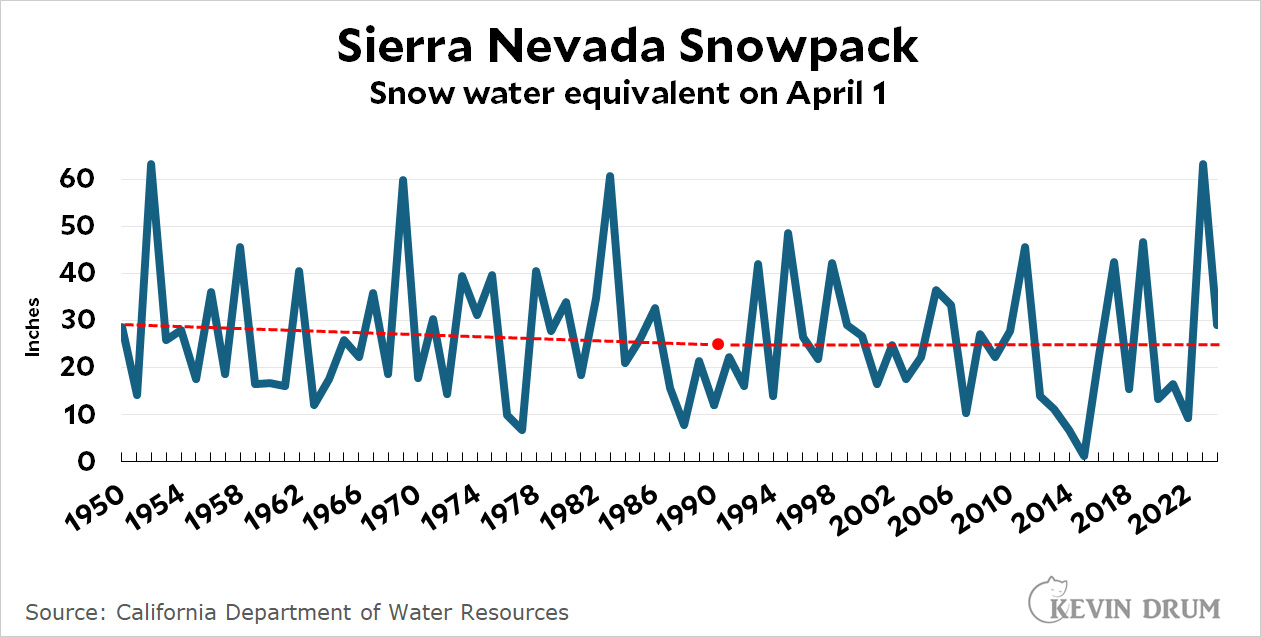Peak snowpack in the Sierra Nevada is typically measured on April 1, so the numbers are in for 2024: we ended up about 9% above average.
 The snowpack trendline is a little tricky because there are occasional super-years that make it sensitive to exactly when you start. But if you start with the earliest records, what you find is that average snowpack declined from 1950-90 but has been rock steady since then.
The snowpack trendline is a little tricky because there are occasional super-years that make it sensitive to exactly when you start. But if you start with the earliest records, what you find is that average snowpack declined from 1950-90 but has been rock steady since then.
Still, that's rock steady at a level about three inches less than in the '50s. Any way you look at it, we're getting less rain and snow these days than we used to.

Colorado River (upper basin) is doing OK too:
https://wcc.sc.egov.usda.gov/reports/UpdateReport.html?textReport=Upper+Colorado+River+Basin&textRptKey=16&textFormat=SNOTEL+Snow%2FPrecipitation+Update+Report&StateList=Select+a+State&RegionList=16&SpecialList=Select+a+Special+Report&MonthList=April&DayList=2&YearList=2024&FormatList=N0&OutputFormatList=HTML&textMonth=April&textDay=2&CompYearList=select+a+year
Though median values are from the years 1991 thru 2020, so still on the low side historically?
One other issue--warmer weather means faster water losses...so more water needed now.
Rock steady except for that whole zero thing. The modulation of the signal in the data there is... concerning.
Just another data point in the "the future is going to be terrifying, climate-wise" column.
"Still, that's rock steady at a level about three inches less than in the '50s. ..."
What are the error bars on those numbers?
California's problem, for the moment, is not too little water, it's too many people and too many almonds.
In the long run the projections are for at least as much total water (the greenhouse effect means more water in the atmosphere), but less snow, so preparations should be made - maybe more dams (or fewer people).
Need fewer tree crops that need year round irrigation.
But the good news is that all but two of the major California reservoirs are above historic averages.
https://cdec.water.ca.gov/resapp/RescondMain
they need to be worried about ground water recharge.
Not going to dispute that. But it is complicated. Have to have the right geology, and the State (or water managers) have to get the water to those sites, and the land owners, (if not the State) have to agree.
Oh, it costs money. How to pay for it?
They have found evidence that Indians semi-damed valleys that empty onto plains, that served to recharge the groundwater.
Also, the amount of snow can offset the amount of liquid water storage. As things get warmer the snow level gets less and people will need more water storage facilities.
They're also considering getting help from The Beaver:
https://www.latimes.com/environment/story/2024-03-26/beavers-can-help-mitigate-megafires-california
though this is mainly to control wildfires, it can have an impact on water as well (for better or worse).
(So how come when humans mess with the environment it's a bad thing but when beavers do it it's part of nature?)
👍👍👍👍👍
Shouldn't this chart be adjusted for inflation? 🙂 OK, not really, but isn't the more relevant measure water per person, or water per acre of farmland, or water per /something/ that has been increasing since 1950? (Here I'm echoing skeptonomist's earlier point.)
Also, as someone who lived in Northern CA during that dip you can see in late 1970s, I can attest that those fluctuations have a huge impact on all things related to the availability of water, from crop production down to such little considerations as how often you should flush your toilet.